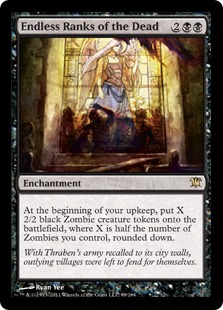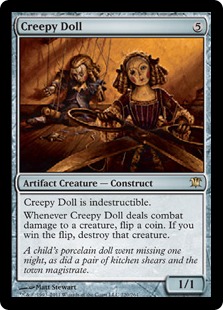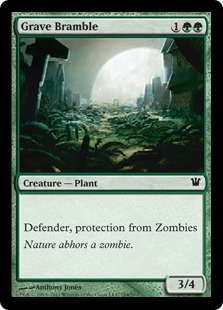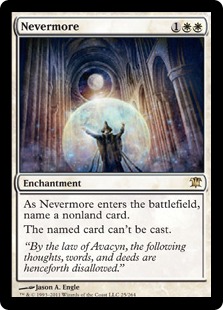Leadoff Question
Sleeves and double-faced cards: what are your experiences? Which sleeve-backs are opaque enough to conceal double-faced cards, and which aren’t? Add your wisdom to the comments section.
The Paradox of Innistrad’s Flavor
Innistrad’s flavor in one word: incredible. The Gothic horror is a welcome change after two blocks that have drawn from different horror wellsprings, Lovecraftian nightmare for Rise of the Eldrazi and the revulsion-inducing body horror of New Phyrexia. Patrick Chapin said on Twitter, “After Nicol Bolas, the rise of the Eldrazi, and then the Phyrexians corrupting everything, this block is kind of relaxing.” Imagine watching television and switching from a blood-spattered show like Dexter to a Miss Marple mystery on PBS; characters are still getting killed in the cozy Agatha Christie adaptation, but it’s more palatable.
While individual cards in Innistrad have their nasty moments (Claustrophobia? Eep!), the set as a whole spreads around the nightmares and has ample “breathing room” from the ghastliness with cards such as Clifftop Retreat. Of course, for every moment of beauty, there is an Endless Ranks of the Dead, a Zombie horde filtered through a stained-glass window. This card, more than any other, represents Innistrad, and the wallpaper reveals even more details.
May playing with these cards turn out to be half as enjoyable as looking at them!
Yet as I browse through the set, I sense a paradox in Innistrad’s flavor. More than any other set in recent memory, it is built on the outside world, replete with references and homages. This is not to say that its Gothic horror is merely derivative or a pastiche; instead, the last few centuries of Western horror media are filtered through a uniquely Magic: The Gathering lens. If the Time Spiral set was like Final Fantasy XI, an online game so wrapped up in its own mythology that it rarely references the world outside, then Innistrad is more like World of Warcraft, wise to recent events and quick to comment on them while maintaining its own identity.
How recent? Delver of Secrets | Insectile Aberration is based on 1950s science fiction-horror film The Fly; Mark Rosewater (@maro254 on Twitter) said it outright. Though I disagree with his conclusion, I have to hand it to card alterist Andrew Sitte for pointing out an apparent reference to a previous Wizards of the Coast game, Vampire: The Eternal Struggle, that also had a card called Sensory Deprivation in its first expansion, Dark Sovereigns, from December 1995. (Based on Steven Belledin’s version of events, he was not aware of the V:TES Sensory Deprivation, but someone else in Wizards might have recognized the parallel.)
The references aren’t just from last millennium, either. Creepy Doll was inspired by Jonathan Coulton’s 2006 song of the same name, once more confirmed by Mr. Rosewater in a reply to an obviously flattered tweet from Mr. Coulton. Grave Bramble? “100% a shout-out to Plants vs. Zombies.” So sayeth the MaRo, about a game that came out in 2009.
This set has more references than a small-town library, or, if you prefer, more Easter Eggs than this page. Yet there is also a barrier around Innistrad, fluorescent yellow crime scene tape wrapped around Gothic columns, black letters spelling it out: Thought Police Line – Do Not Cross.
A card with a name like Nevermore conjures up John Astin reciting Edgar Allan Poe, but there is no raven in Innistrad, much less a quote from “The Raven,” the poem that took the word out of the English language except as a callback to Poe. Think Neil Gaiman’s American Gods, when one of Odin’s ravens snaps on hearing the “nevermore” joke one time too many and says [Hey, this is a family site! – LL]. [Hey, I didn’t make that edit! That was probably my Evil Twin. –the real LL]
The prohibition on real-world flavor text and names outside the Core Set is firmly in place, and that’s why there may be a Rooftop Storm going on in Innistrad, but what it animates will not be a Frankenstein’s Monster. (As the November 12, 2010 Card of the Day on the main Wizards of the Coast site, Frankenstein’s Monster got this commentary: “Frankenstein’s Monster combines two things that no longer happen on Magic cards: direct references to the real world and combining different kinds of counters.”)
“Direct references” is the key here. A plant that hates zombies? It’s in. Creepy dolls are common enough to let slide. Nevermore has one use that overshadows them all, but it still appears in dictionaries and so is fair game. “Frankenstein’s Monster” is too direct a reference, and even if the card itself weren’t a design mess, the name would be out.
There are also a number of missed opportunities, places Magic couldn’t go for legal reasons; “The Fly” is still under copyright, for example, and so the Insectile Aberration side of Delver of Secrets has its long flavor text instead of the obvious pick, “Help me! Help me!” In some cases, even an indirect reference would have been a bad idea; though the music video for “Thriller” is a pop-culture icon, the Plants vs. Zombies “Dancing Zombie” incident likely made Wizards steer clear of even the most oblique Michael Jackson mentions.
The paradoxical tension between Magic’s creative rules and the thematic origins of Innistrad is most apparent when looking at a card not even in the set. Consider Taste of Blood: two fang-holes, one Dracula quote. Now compare it to Nevermore; that word is “The Raven” and Edgar Allan Poe, but neither the poem nor its author gets to duck under the tape put up by the Thought Police. Instead, Nevermore gets a quote that is reminiscent of an entirely different brand of horror: the dystopian nightmare of George Orwell’s Nineteen Eighty-Four. In Innistrad, the Thought Police wear tricorne hats, and the Church of Avacyn is the Ministry of Love.
There is a great richness to the flavor of Innistrad, but until Nevermore is printed in Magic 2013 with flavor text that ends with “—Edgar Allan Poe, ‘The Raven,’” the set is not complete.
The Standard Deck I Wanted to Be Good: Discount Window
Discount Window is an artifact-oriented Heartless Summoning build, taken to its linear and logical conclusion. The name comes from a concept in monetary policy. Hey, if breakfast cereals are fair game for deck names, surely central banking can’t be too far behind?
Creatures (28)
- 4 Wurmcoil Engine
- 4 Grand Architect
- 4 Molten-Tail Masticore
- 4 Precursor Golem
- 4 Phyrexian Metamorph
- 4 Moltensteel Dragon
- 4 Myr Superion
Lands (13)
Spells (19)

There’s nothing subtle about the concept: make large, efficient creatures cost less, and starting on the third and fourth turns, land haymaker after haymaker to overwhelm the opponent. Running Heartless Summoning into Myr Superion second turn is the dream (add Myr Superions to make it even more ridiculous), but I’m wondering if Myr Superion will prove a trap for builders of Heartless Summoning decks; Heartless Summoning alone is not enough to make Myr Superion work, and even the obvious next step of adding Grand Architect leaves such a deck shaky.
Semblance Anvil, though far less efficient than Grand Architect or Heartless Summoning, makes the deck much more stable—at least in goldfishing. In a format of Ancient Grudge and Creeping Corrosion alongside other vexations, this is a have-fun deck, not a win-tournaments deck, so I won’t be piloting this at the Standard Open in Indianapolis. I have a hunch that a deck like this will be the right metagame call for one week within the next four months. I just don’t know which week.
Affinity in Legacy and a Few Thoughts on Stony Silence
If I play Legacy at the Indianapolis Open Weekend, it will be for one round only, to pick up my fifteenth Open Point and secure places at the Charlotte Invitational (I’ll have to see if my work schedule allows for the trip) and an Invitational next year; thus, I have no reason not to show my latest Legacy build.
Unsurprisingly for those who have followed me, the deck has its roots in Affinity. I’ve been corresponding with David Hart about the archetype ever since he found my Invitational list online. We’ve passed ideas back and forth, and the results have been strange and awesome, ending in a clean break from the deck’s namesake mechanic. In the vein of “Garfield Minus Garfield,” meet “Affinity Minus Affinity.”
Creatures (24)
Planeswalkers (4)
Lands (20)
Spells (12)
Sideboard

The Affinity archetype (I doubt the name is going anywhere) seems to do best when ignored or in unsettled formats; in other words, when the field doesn’t know where to aim its sideboards and Affinity gets lost in the shuffle. The banning of R&D’s Mental Misstep may put more combo in the metagame for the short-term, though, so watch for that and keep the sideboard heavy on the discard if you choose Affinity for Indianapolis.
Of note is that the entirety of the “Affinity Minus Affinity” deck would be Modern-legal if not for bannings, and players looking to get into Modern and Legacy at the same time might be drawn to the archetype for cost and similarity of feel.
There’s been considerable hype around Stony Silence in Innistrad, but aside from Enchantress players getting a new toy in Legacy, I don’t see it having as much impact as others think, with the impact going down in proportion to the available card pool. Consider the Tempered Steel decks of Zendikar/Scars of Mirrodin Standard:
What does Stony Silence hit in this build? Glint Hawk Idol, but only the activated ability; the enter-the-battlefield trigger still works. Steel Overseer is rotating out. Inkmoth Nexus is simply a land before it’s activated, so Stony Silence doesn’t affect it. Mox Opal is the most obvious point-of-hurt in the main deck, and while Shrine of Loyal Legions and Spellskite are hit out of the sideboard, Stony Silence doesn’t do as much against this deck as a simple board-sweeper.
Gavin Verhey largely covered my thoughts on Stony Silence in Modern; in short, the more diversified mana bases of Modern Affinity decks, as forced by the banned list, are less vulnerable to disruption than a steady diet of artifact lands. If anything, the value of Stony Silence is that it allows for a split with Kataki, War’s Wage in decks piloting white. This makes it more difficult for the Affinity pilot to sideboard effectively; think of the myriad graveyard-blocking options for those looking to bedevil Dredge decks. That said, both Stony Silence and Kataki, War’s Wage cost two mana; a Spell Snare or two might be in my Modern Affinity future.
Art of rk post Update
The results are in, and rk post (artist guest at the StarCityGames.com Indianapolis Open Weekend) has no illustrations in Innistrad. Assuming a ten-card signing limit (I have no specific information on Mr. post’s preferences, but I’ve rarely had problems getting ten cards signed in one go), here is my suggested card list for when you tell him hello and thank you:
1 Ichorid
1 Mountain (Shadowmoor) or Swamp (Shadowmoor)
1 Unmask
3 cards to fill out a playset or get other favorites signed
This set of ten strikes a balance between his famous Gothic women and heavily played cards in a range of formats.
My Prerelease Impressions
After one Prerelease flight playing with the double-faced cards, I don’t like them. They cause clumsy interruptions in gameplay, whether pulling cards out of sleeves to flip them or swapping checklist cards for the real thing, and I’ve seen people have trouble with sleeve opacity, even within a brand—my Ultra-Pro matte red sleeves won’t work, but the blue ones will. My preferred Constructed sleeves aren’t opaque enough, though my preferred Limited sleeves with Legion’s bacon design are fine. Remember to share your wisdom about sleeves that work and sleeves that don’t in the comments section.
I’m hoping the tournament experience gets more efficient and Wizards shows us more dimensions of double-faced cards in future sets; otherwise, I don’t think the double-faced cards will have been worth the stress.
In my Prerelease flight, I put a Butcher’s Cleaver on an Invisible Stalker and used Snapcaster Mage to give Smite the Monstrous flashback. That 4-0 deck gave me a hint of how the Stalker and Mage will play with Sword of Feast and Famine and Dismember in Standard. As Brad Paisley put it in “Welcome to the Future,” “Wherever we were going, well, we’re here.”
If you see me and my tie at the Indianapolis Open Weekend, please come up and chat, and as always, thanks for reading.
— JDB
@jdbeety on Twitter







